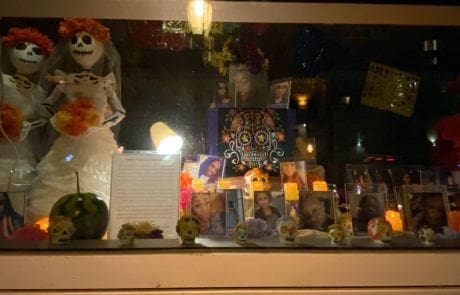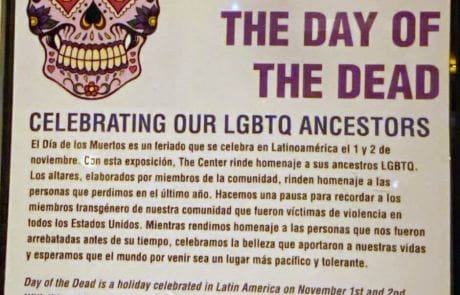A dedication to the deceased
Day of the Dead (Día De Los Muertos) is a two day holiday that reunites the living and dead. Families create ofrendas (Offerings) to honor their departed family members that have passed. These altars are decorated with bright yellow marigold flowers, photos of the departed, and the favorite foods and drinks of the one being honored. The offerings are believed to encourage visits from the land of the dead as the departed souls hear their prayers, smell their foods and join in the celebrations!
Day of the Dead is a rare holiday for celebrating death and life. It is unlike any holiday where mourning is exchanged for celebration.
Día de los muertos es una fiesta de dos días que reúne a los vivos y a los muertos. Las familias crean ofrendas para honrar a los familiares que han fallecido. Estos altares están decorados con flores de color amarillo brillante, fotos de los difuntos, y las comidas y bebidas favoritas del que se está honrando. ¡se cree que las ofrendas animan las visitas de la tierra de los muertos mientras las almas aparecidas escuchan sus oraciones, huelen sus alimentos y se unan a las celebraciones!
Calaveras / Skulls
Calaveras are ubiquitous during Day of the Dead. The skulls are often drawn with a smile as to laugh at death itself. They take many forms such as sugar candies, clay decorations, and most memorable: face painting. Sugar skulls are decorated and placed on ofrendas of loved ones. A Calavera, or sugar skull, is a decorative skulls made (usually by hand) from either sugar (called Alfeñiques) or clay which are used in the Mexican celebration of the Day of the Dead.
Las Calaveras son ubicuas durante el día de los muertos. Los cráneos a menudo se dibujan con una sonrisa como para reír a la muerte misma. Toman muchas formas como caramelos de azúcar, decoraciones de arcilla, y más memorables: Pintura de cara. Los cráneos de azúcar están decorados y colocados en las ofrendas de los seres queridos. Una calavera, o calavera de azúcar, es un calaveras decorativas hechas (generalmente a mano) de azúcar (llamado Alfeñiques) o arcilla que se utilizan en la celebración mexicana del día de los muertos.
Flors de Muerto / Mexican Marigolds
Marigolds are believed to be the pathways that guide the spirits to their ofrendas. The flower’s vibrant colors and scent attract the departed souls, as they return to feast on their favorite foods. They are called “Flor de Muerto” (Spanish for Flower of Dead) and they symbolize the beauty and fragility of life. Marigold flowers include around 60 annuals and perennials that are native to Mexico and Central America.
Se cree que los caldos son los caminos que guían a los espíritus a sus ofrendas. Los colores vibrantes y el aroma de la flor atraen a las almas que se han ido, mientras vuelven a deleitarse con sus alimentos favoritos. Se les llama Flor de muerto y simbolizan la belleza y fragilidad de la vida. Flores de marígo incluyen alrededor de 60 anuales y perennes que son nativos de México y Centroamérica
The Center on Colfax has displayed ofrendas in our windows to celebrate the lives of those we have lost in the community over the past year.
Ofrendas / Offerings
While the most recognizable aspects of Day of the Dead are the representations of skulls and skeletons, the tradition that holds the most meaning is the Ofrenda (Spanish for offering). The Ofrenda is what the whole celebration is about; it’s a collection of offerings dedicated to the person being honored.
Mientras que los aspectos más reconocibles del día de los muertos son las representaciones de cráneos y esqueletos, la tradición que tiene más significado es la Ofrenda (español por ofrecer). La Ofrenda es de lo que trata toda la celebración; es una colección de ofrendas dedicadas a la persona que es honrada.
A brightly colored Oilcloth covers the table and on top of that sits a collection of photographs and personal items of the departed person. The lower portion of the altar is where the offerings are placed, from traditional Mexican cuisine to other items that represent the honored person’s particular tastes.
Una tela de aceite de colores brillantes cubre la mesa y encima de ella se encuentra una colección de fotografías y artículos personales de la persona que se ha ido. La parte inferior del altar es donde se colocan las ofrendas, desde la cocina mexicana tradicional hasta otros artículos que representan los gustos particulares de la persona honrada.



